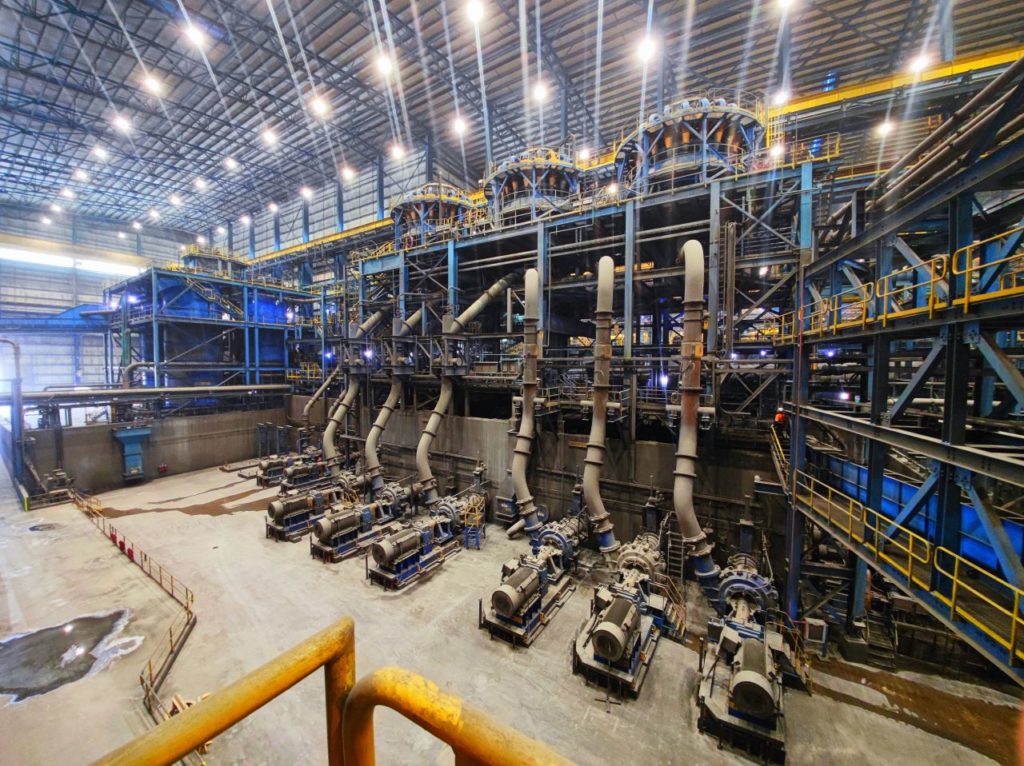Despite the current issues regarding the Oyu Tolgoi copper-gold mine and mining project between the Mongolian Government and Rio Tinto, which manages the operation, the mine continues to run very successfully both in terms of current open pit production and the ongoing underground project expansion, despite COVID-19 challenges. Oyu Tolgoi LLC is jointly owned by the government of Mongolia, which has 34% ownership, and Turquoise Hill Resources, which owns 66%. Rio Tinto owns 50.8% of Turquoise Hill Resources and manages the operation on behalf of the owners.
As an example in the concentrator, the main annual scheduled shutdown finished on January 1, and was completed by 100% Mongolian staff without any safety issues. In all, 447 people completed 1,270 tasks for a 12 day total of 33,400 man hours. The project has deployed a number of mitigations that include extended on-site rosters, securing commitments from critical vendors to remain on site for extended periods and layered screening of personnel. Oyu Tolgoi LLC recently stated: “All of Oyu Tolgoi’s achievements are the result of the hard work and dedication of our employees. We wouldn’t be able to build a mine that can compete with the best in the world without the young people who are carrying the giant construction on their backs in difficult conditions.”
Rio Tinto is also deploying equpiment in the wider country to help combat the pandemic. On January 16, the first batch of PCR equipment arrived in Ulaanbaatar, as part of 4 PCR labs funded by a $602,000 voluntary commitment from Rio Tinto.
In its Q4 2020 operations review, Rio Tinto said mined copper production from the open pit was 2% higher than in 2019, reflective of the anticipated move to higher grade areas of the open pit, primarily due to accelerated mine development and production phasing. In the fourth quarter, pit phasing delivered higher gold production (+139%) compared to the prior quarter. Access to higher copper and gold grades is expected to continue throughout 2021. “We maintained shipments across the Chinese border despite COVID-19 measures in Mongolia. We continue to work closely with authorities to manage the risk of supply chain disruptions due to COVID-19.”
On to underground mine progress, and Rio Tinto says overall underground lateral development has now reached 53,000 equivalent metres (eqm), with development for first drawbell substantially complete. The project has now exceeded one million tonnes of material moved through Shaft 2 since commissioning and scheduled annual maintenance of the shaft was successfully completed in October 2020 using remote technology.
Shaft 4 is now out of care and maintenance and the focus is on completing all construction and commissioning activities for load testing and verification, and for sinking to commence in early 2021. Shaft 3 remains on care and maintenance, with some minor construction.
On 16 December, Rio Tinto confirmed the definitive estimate of cost and schedule for Panel 0 with sustainable production expected to commence in October 2022 and development capital of $6.75 billion, in line with previously announced ranges. These estimates include the known impacts of COVID-19. At peak production, Oyu Tolgoi is expected to operate in the first quartile of the copper cash cost curve and by 2030 is expected to be the fourth largest copper mine in the world. It is expected to produce 480,000 t of copper per year on average, from 2028 to 2036, from the open pit and underground. The underground Ore Reserve has an average copper grade of 1.52%, which is more than three times higher than the open pit Ore Reserve, and contains 0.31 grammes of gold per tonne.
Back to the outstanding high level issues, on 4 January 2021, the Government of Mongolia advised Rio Tinto that they were dissatisfied with the results of the definitive estimate and the funding implications for the sharing of economic benefits between the shareholders of Oyu Tolgoi. Rio Tinto states: “The Government has also stressed the importance of achieving a comprehensive solution which addresses the social issues of importance to Mongolia, such as water usage and the corporate tax payments which have been referred to International Arbitration. We have been engaging with the Government and Turquoise Hill Resources (TRQ) to address these recent challenges within the scope of Parliament Resolution 92, and remain open to improving the Underground Development and Financing Plan (UDP) to deliver even greater benefits from Oyu Tolgoi to all stakeholders.”
Rio Tinto added that additional milestones need to be met in order to ensure that the project can commence caving operations in 2021, including: outstanding government approvals – including registering the updated Resources and Reserves submitted in February 2020 and accepting the updated feasibility study (OTFS20) completed in July 2020 in accordance with the 2009 Investment Agreement and Mongolian regulation; funding as agreed with TRQ in the MOU in September 2020; and, achieving the power milestones agreed with the Government of Mongolia in June 2020. “We continue to work closely with our partners, the Government of Mongolia and TRQ in the coming months to finalise these milestones.”











